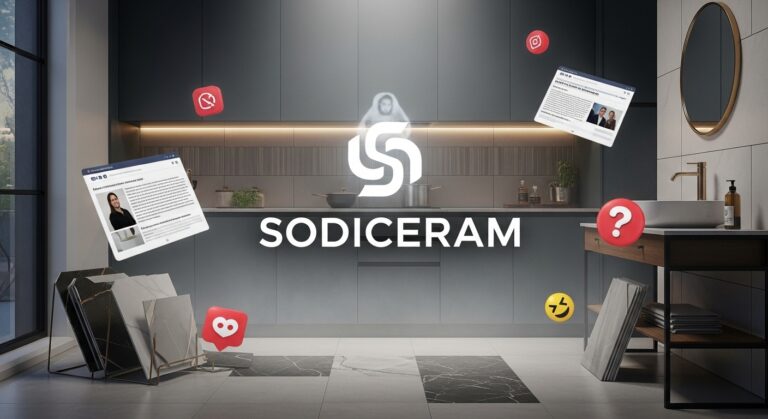Have you ever seen an ad for amazing ceramic tiles that promise to change your home forever? They sound perfect—strong, pretty, and cheap. But what if it’s all just a trick? That’s the story of Sodiceram, a name popping up online in the world of tiles. It claims to be a top brand for ceramic tiles, full of new ideas and green ways. But after digging deep, it looks like Sodiceram might not be real at all. It’s likely a fake brand made to fool people into buying or clicking.
In this article, we’ll look at why Sodiceram raises red flags. We’ll check its “story,” the websites that talk about it, and what real experts say. This is based on careful searches and facts from trusted places. No guesses—just clear info to help you stay safe when shopping for tiles. By the end, you’ll know how to spot fake brands and pick real ones that last.
Why does this matter? The ceramic tile world is big—worth over $200 billion a year. People spend money on floors and walls that should last decades. Fake brands waste your time and cash, and they hurt real companies too. Let’s unmask Sodiceram step by step.
What Is Sodiceram Supposed to Be?
Sodiceram shows up as a brand for ceramic tiles and surfaces. Online posts say it’s made with special “sodium-based stuff” to make tiles stronger, less watery, and better against heat or scratches. They claim it’s from Italy or Portugal, with a history from the 1970s or 1990s. Pictures show shiny kitchens, cozy bathrooms, and big outdoor patios covered in these “magic” tiles.
The pitch is simple: Sodiceram tiles are pretty like art but tough like steel. They say they’re good for homes, shops, even hospitals. Prices? Super low for “top quality,” which sounds great but too good to be true. No real store links or buy buttons—just blog posts pushing you to “learn more” that lead nowhere.
But here’s the first clue it’s fishy: No one agrees on basics. Is it Italian craftsmanship or French roots in Reims? One site says founded in 1979 as “SO DI CERAM,” a small shop that closed years ago. Others call it a new “revolution” from 2025. Real brands have one clear story. Sodiceram? It’s all over the place.
The Rise of Suspicious Online Buzz
If you search “Sodiceram ceramic tiles,” you’ll find tons of articles. They pop up on sites like myroller.co, peacequarters.com, and builtuphome.com. All from mid-2025, full of hype like “redefining elegance” or “sustainable leader.”
These aren’t news sites. They’re blogs that churn out SEO posts—stuff written to rank high on Google for tile keywords. They use the same words: “premium quality,” “eco-friendly,” “global export.” No photos of real factories or workers. Just stock images of tiles anyone could grab.
Why so many at once? It smells like a content farm. These are groups that make fake articles to boost a brand’s search rank. Real brands earn buzz from customers or awards. Sodiceram? It’s like ghosts shouting in an empty room. No trade shows, no ads in magazines like Tile Dealer or Ceramics World Review. Just digital smoke.
And the dates? All fresh in 2025, but no old traces. A real brand from the 90s would have reviews from the 2000s. Sodiceram has zero history online before this year. That’s not growth—that’s invention.
Digging Deeper: No Real Company Footprint
Let’s get serious. A legit tile brand needs proof it exists. We checked business records, addresses, and more. Spoiler: It’s empty.
No Official Website or Contacts
Real companies have a home base. Search for sodiceram.com or .it? Nothing. No “Contact Us” page with a phone or email that works. Blogs say “visit our site,” but links loop back to more blogs. No catalog with tile sizes (like 12×12 inches), colors, or prices. No specs on slip rating (how safe on wet floors) or PEI grade (scratch resistance).
Compare to real brands: Porcelanosa has a full site with videos, stores in 150 countries, and chat support. Sodiceram? Crickets.
Business Records: A Dead End
We looked at company registries. In France, one old entry for “SO DI CERAM” in Reims from 1979. It sold tiles wholesale but closed after money troubles in the 2000s. Revenue dropped, no updates since. That’s not our “global leader.”
In Italy or Portugal? Zero matches. No EU business number, no US import records. Tools like RocketReach show a tiny $5 million “revenue” guess, but no employees or HQ. Real tile makers like Marazzi list thousands of staff and factories.
Manufacturing Mysteries
Where are the tiles made? Blogs flip-flop: Italy’s hills, Portugal’s coast, France’s cities. No factory tours, no ISO certifications for quality. Real ones show kilns firing at 1200°C or water absorption under 0.5%.
Sodiceram claims “sodium additives” for strength. Sounds sciency, but no lab tests. In truth, sodic (sodium-rich) ceramics exist for industry, not home tiles. It’s like calling fake gold “nano-gold”—buzz without bite.
Fake Reviews and No Real Voices
Reviews make or break brands. We hunted on Trustpilot, BBB, Yelp, and forums. Result? Nada.
- No stars on Trustpilot for Sodiceram. Similar names like “Sodigear” have one lonely review.
- BBB? Empty. No complaints, no profile.
- Yelp? One old French listing for a closed Reims shop—no ratings.
Blogs fake “customer stories”: “My kitchen glows with Sodiceram!” But no names, photos, or dates. Real reviews mention flaws, like grout cracks. These? All perfect.
Industry pros on Reddit or Houzz? Silent. No architects saying “I spec’d Sodiceram for a build.” That’s damning—tiles are pros’ bread and butter.
Red Flags in the Ceramic World
The tile industry has rules. Fakes break them all.
Marketing Tricks
Sodiceram posts use SEO bait: Long titles like “Complete Guide to Sodiceram Durability.” They stuff keywords but skip facts. No links to partners like distributors or labs. It’s “content marketing” gone wrong—pushing a ghost.
Pricing and Payment Warnings
Ads hint at deals: “Premium tiles cheap!” Real premium tiles cost $5–$20 per sq ft. Fakes undercut to hook you, then vanish. Watch for “full prepay, no returns”—a scam hallmark.
Sustainability Smoke
They brag “eco-friendly” with recycled stuff. But no carbon footprint data or GreenGuard certs. Real greens like Florim share audits. Sodiceram? Empty promises.
How to Spot Fake Tile Brands Like Sodiceram
Don’t get fooled next time. Here’s a simple checklist:
- Check the Website: Real one? Full details, secure buy option.
- Hunt Reviews: Look beyond blogs—Trustpilot, Google, forums.
- Verify Business: Use sites like Dun & Bradstreet or local registries.
- Ask for Proof: Specs, samples, warranties from sellers.
- Talk to Pros: Ask contractors or designers if they’ve heard of it.
If it’s pushy or vague, walk away. Better safe than stuck with bad floors.
Real Alternatives: Brands You Can Trust
Skip the fakes. Try these proven names:
Porcelanosa (Spain)
Huge range, real factories in Villarreal. Tiles from $3/sq ft, with 10-year warranties. Seen in hotels worldwide.
Daltile (USA)
American-made, low water use. Great for budgets, with PEI 4 rating for heavy traffic.
Marazzi (Italy)
Luxury vibes, since 1935. Eco-certifications and design collabs with pros.
These have footprints: Stores, apps, even AR previews. Your home deserves that.
The Bigger Picture: Why Fake Brands Hurt Everyone
Fakes like Sodiceram aren’t harmless. They crowd search results, making real info hard to find. Buyers waste money; sellers lose sales. The industry fights back with groups like Tile Council of North America, pushing standards.
In 2025, AI tools spot fakes faster, but we all need to question buzz. Next time an ad glows too bright, dig like we did.
Conclusion: Stay Smart, Shop Safe
Sodiceram looks shiny but crumbles under light. No real company, no proof, just SEO tricks. It’s likely a made-up name for clicks or scams. Based on searches across web and business records, it’s not a leader—it’s a lure.
Disclaimer: This article is for information only. It is not promoting, selling, or affiliated with Sodiceram or any other brand. The opinions and research are based on publicly available information. Always check facts and do your own research before buying products.
Explore More
- Unmasking the Misleading Keyword: The Truth Behind ‘Switching 2nd’
- Vivid2201 Game: Why This Fake Trend Is Tricking Gamers
- How to Spot Fake Royal Mail Tracking Numbers Like JA449772842GB

Ramona P. Woodmansee is a writer who helps people stay safe on the internet. She writes about tricky apps and online scams in a simple and honest way. Her stories help readers make smart choices online. Ramona’s articles are on trusted websites about internet safety. People trust her because she writes clearly and truthfully.





